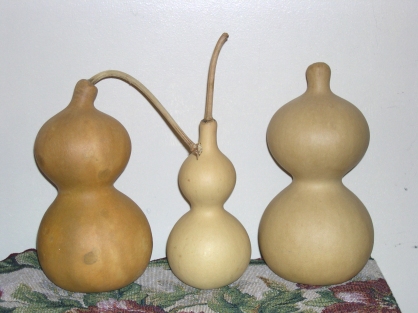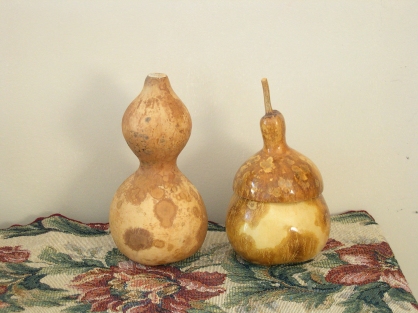|
The Gourd Report
This is a book we printed and sold at gourd shows. now for your convenience, it is free here at The Gourd Reserve.
The Gourd Report is based on expirimental methods of cleaning gourds to make this seasons gourds ready to craft in time for Christmas. Reader
should be aware that this is an expirimental procedure, and is not fool proof. We lost several gourds during our experminet, and now two
years later, we are still leanring more. Like for instance Hyakunari's that have sat for about 6 weeks and are still as green as the day they
were picked, are more likely to survive the rapid clean and oven dry process than the one's that begin to turn brown at the top.
The smaller the gourd, the better candidates they are for this process, the larger the gourds, the less likely. WE DO NOT
recommend you try this proceedure on any kettles, or gourds that weigh over 10 pounds fresh picked and green.
That being said, I hope you find the Gourd Report educational and inspiring for some of your crafting experience.
The Gourd Report
Vol 1. - Drying Gourds
Vital and informative
information for Gourders
of all levels of expertise.
Acknowledgement, We would like to thank Tim Moyers for his artwork, for starting the Gourd Reserve, and for all the support he has been
over the years. “Giving” people like Tim are hard to find, and we would like to give credit where credit is due.
Cover Art by Tim Moyers - The Gourd Reserve
Photo’s and text by Dan & Carmella Dunkin
of The Gourd Reserve
Published by The Gourd Reserve
© 2002
The Gourd Report
Vol 1. - Drying Gourds

Hyakunari’s left to right, a dry cleaned, green cleaned, and rotted gourd, 3 methods explained in this booklet.

Example of Combined Technique to enhance the mold markings for special effects, also explained in this booklet.
The Gourd Report
Vol 1. - Drying Gourds
Introduction:
The purpose of this book is to help people understand many different techniques to clean gourds, but not just to clean
them, but also to be aware of possible hazards in handling gourds.
There are two primary hazards in handling gourds, one is the mold that grows on them, the other is the dust created by
scraping, brushing, or sanding the inside and or outside of the gourd.
MOLD:
All mold spores can be hazardous. If you are drying gourds, and allow them to acquire mold on the surface, you should not have them in your house
or garage. Mold can be kept off your gourds by wiping or spraying them with a bleach solution, (about a half cup per gallon), every day or two.
Once mold is allowed to grow on the gourd, it should be handled with care, you don’t want to stick your head down in a barrel or pile of gourds
that have been alllowed to mold, and start digging through them to find a specific gourd. when the omld is bumped or jarred, it can release
millions of spores, which can be breathed into your lungs, and cause severe problems. The most common problems from mold spores are flu like
symptoms, headaches, congestion with a cough, that can last for weeks, but worse than this, some molds can have negative health effects later in
life. Our next booklet will cover Histoplasma Capsulatum spores, and Histoplasmosis, a disease caused by these little mold spores, and will show
some of the long term effects that this particular mold can cause.
Mold Spores are light, they float in the air. If you have a pile of gourds to pick through, use your hose to hose
| 


